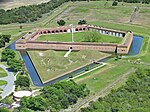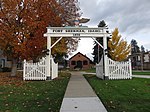Alabama

- Fort Armstrong
- Fort Bibb
- Fort Bowyer
- Fort Carney
- Fort Claiborne
- Fort Condé, open to the public
- Fort Crawford
- Fort Dale
- Fort Decatur
- Fort Easley
- Fort Gaines
- Fort Glass
- Fort Hampton
- Fort Harker
- Fort Hull
- Fort Jackson, open to the public
- Fort Landrum
- Fort Leslie
- Fort Likens
- Fort Madison
- Fort McClellan
- Fort Montgomery [1]
- Fort Morgan, open to the public
- Fort Novosel, closed to the public
- Fort Sinquefield
- Fort Stoddert
- Fort Strother
- Fort Tombecbe, open to the public [2]
- Fort Toulouse, open to the public
- Fort Williams, destroyed by erosion
























